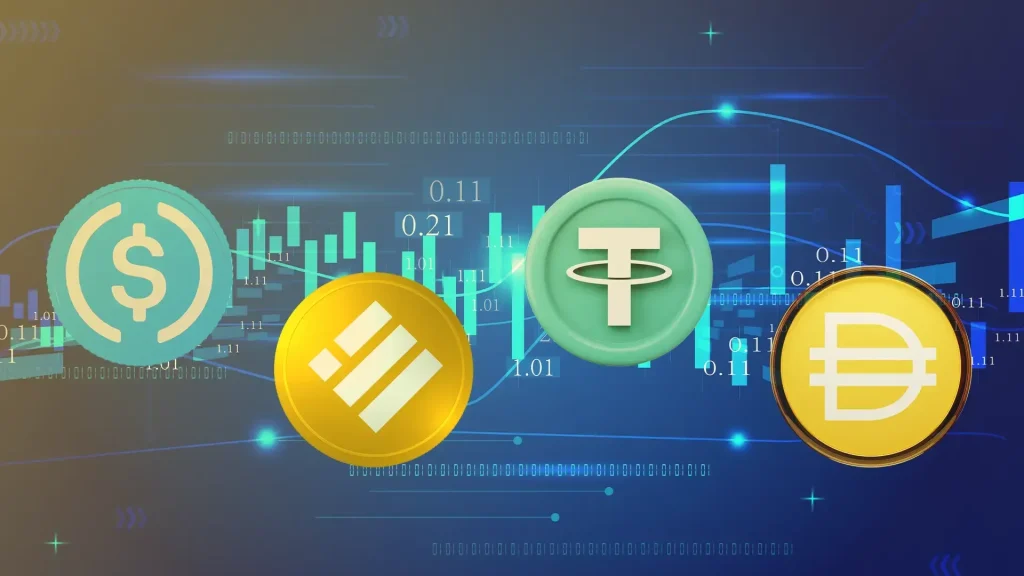Stablecoins are revolutionizing the financial landscape, especially highlighted at the recent Bitcoin 2025 conference. These dollar-pegged digital assets are emerging as pivotal players in reshaping U.S. economic power, a notion strongly supported by Vice President JD Vance’s endorsement of the GENIUS Act aimed at regulating the stablecoin market. As the SEC shifts to a more favorable stance, major financial institutions are poised to explore this dynamic segment further. Tether’s CEO emphasized that stablecoins could serve half the world’s population currently underserved by traditional banking systems. With such potential, the legislative momentum surrounding stablecoins could pave the way for a new era in cryptocurrency regulation and broader financial inclusion.
Digital currencies, particularly those maintaining a fixed value like stablecoins, are becoming crucial components of the evolving monetary system. Known colloquially as digital dollars, these cryptocurrencies are not only facilitating transactions but also offering a bridging mechanism for those disenfranchised by the conventional banking apparatus. The financial community is witnessing a shift, as legislative efforts such as the GENIUS Act gain traction, aiming to provide a structured regulatory environment for these assets. With major crypto players like Tether leading the charge in the stablecoin market, the implications extend far beyond mere investment, touching on global economic dynamics and inclusivity. As discussions around stablecoin regulation heat up, the future looks promising for these innovative financial instruments.
The Growing Importance of Stablecoins in the Crypto Market
Stablecoins have emerged as crucial components of the cryptocurrency ecosystem, showcasing a unique ability to combine the benefits of digital assets with the stability of fiat currencies. These dollar-pegged tokens offer users predictable value and ease of transaction, making them appealing for both individual investors and large institutional players. As the cryptocurrency market matures, the role of stablecoins is becoming more prominent, serving as a bridge that connects traditional financial systems with the decentralized world of crypto.
At the Bitcoin 2025 conference, discussions around the future of stablecoins highlighted their potential to transform the financial landscape. With significant endorsement from political figures like Vice President JD Vance, who referred to stablecoins as a “force multiplier” for U.S. economic power, it is clear that there is a strong governmental push towards integrating these digital tokens into mainstream finance. This shift not only signals a growing acceptance but also points to the critical role stablecoins can play in expanding financial access globally.
Regulatory Developments and the GENIUS Act
The regulatory framework surrounding stablecoins is rapidly evolving, with the introduction of the GENIUS Act representing a landmark moment in U.S. cryptocurrency legislation. This comprehensive bill aims to establish clear guidelines for stablecoin issuers, providing a pathway for banks and other financial institutions to engage with this innovative financial technology. As the SEC retreats from aggressive enforcement actions, the atmosphere is becoming more conducive for stablecoin adoption, allowing traditional players to explore this space confidently.
Sen. Cynthia Lummis emphasized the importance of the GENIUS Act at Bitcoin 2025, stating that its passage would mark the first significant piece of digital asset legislation from the Senate. The push for regulation is crucial, as it not only enhances legal clarity but also protects consumers and investors in the rapidly expanding stablecoin market. By bringing stablecoins under a regulatory umbrella, stakeholders hope to unlock their full potential, contributing to the U.S. maintaining its lead in the global financial system.
Tether’s Role in the Stablecoin Landscape
Tether stands at the forefront of the stablecoin market, commanding over 60% of the market share. As the largest stablecoin issuer globally, Tether plays an instrumental role in shaping the dynamics of both cryptocurrency and traditional finance. CEO Paolo Ardoino has positioned Tether as a solution for the unbanked, asserting that stablecoins like Tether serve a vital purpose in financial inclusion and innovation. This perspective is particularly relevant as discussions around stablecoins evolve, emphasizing their use as a tool for reaching underserved populations.
As major banks begin to explore the development of their digital currencies, Tether’s strategy differs significantly. By focusing on the unbanked and those without access to financial services, Tether is carving out a unique space in the financial ecosystem. This approach not only fulfills a critical market need but also raises important questions about competition within the stablecoin domain, as traditional banks may face challenges in replicating Tether’s commitment to broader financial accessibility.
The Impact of the SEC on the Stablecoin Market
The Securities and Exchange Commission (SEC) has historically posed challenges for cryptocurrency and stablecoin issuers, but recent shifts in its approach signal a potential pivot towards greater cooperation. With SEC Commissioner Hester Peirce advocating for clarity and proactive engagement, the path for stablecoin integration into traditional finance appears less obstructed. This change in attitude reflects a recognition of the value these digital assets can bring to the economy, suggesting that the SEC is aligning its focus to support rather than hinder innovation in the stablecoin space.
The SEC’s recent retreat from aggressive enforcement actions opens the door for banks and brokers to enter the stablecoin market, fostering a healthier environment for growth. As regulatory clarity becomes established, stablecoins may play an increasingly pivotal role in shaping future financial infrastructure. The SEC’s evolving stance not only benefits issuers but also enhances investor confidence, preparing the market for the potential mainstream acceptance of stablecoins.
Institutional Adoption of Stablecoins
With the regulatory landscape becoming clearer, major institutional players are starting to take significant interest in stablecoins as a viable investment and transactional asset. The Framework laid out by new regulations under the GENIUS Act aims to pave the way for banks and financial institutions to leverage stablecoins in their services. This could lead to a dramatic transformation in how digital currencies are perceived and utilized within the financial services sector.
High-profile companies, including JPMorgan and Bank of America, are reportedly in discussions to create a unified digital dollar, signaling a shift toward mainstream adoption of stablecoins. Such initiatives showcase a growing recognition among traditional financial entities about the potential of stablecoins to streamline transactions, enhance liquidity, and improve user experience. As these institutions engage with the stablecoin market, they could drive further innovation and competition in this exciting area of digital finance.
Future Prospects for the Stablecoin Market
As we look towards the future, the stablecoin market is poised for substantial growth and evolution. With increasing regulatory clarity and broader acceptance among institutional players, stablecoins may soon become integral components of the global financial system. The potential for stablecoins to help bridge gaps in financial services and empower underserved communities cannot be overstated, which will fuel their adoption worldwide.
Experts, including notable figures at Bitcoin 2025, predict that the next five years could see a new wave of competition in the stablecoin space, as traditional financial players begin to launch their digital currencies. This competitive landscape will likely spur innovation and enhancements in user offerings, while also pushing existing stablecoin issuers to continually improve their products. With mounting interest and investment in stablecoins, their role in the economic ecosystem will only become more significant as we move forward.
The Role of Stablecoins in Financial Inclusion
Stablecoins provide an innovative solution to one of the most pressing challenges in finance: inclusivity. With nearly half of the world’s population lacking access to traditional banking services, stablecoins promise a means to deliver financial solutions to these underserved communities. By facilitating easier access to banking-like services through digital channels, stablecoins aim to become a lifeline for countless individuals globally.
As Tether’s leadership emphasizes, reaching underbanked populations is not just a market opportunity but a moral imperative. Stablecoins can empower individuals by enabling them to participate in the global economy, helping to create pathways for savings, investment, and secure transactions. As awareness and education around stablecoins grow, so too does the potential for these digital assets to drive meaningful change in financial inclusion.
Market Dynamics Shaped by Stablecoin Adoption
The stablecoin market is not only reshaping the cryptocurrency landscape, but it is also influencing traditional market dynamics as robust competition sets in. As established financial entities enter the fray, they introduce various innovative financial products tied to stablecoins, enhancing their appeal to a broader segment of investors. This increased competition may drive improvements in transaction speeds, fees, and user interfaces, ultimately benefiting consumers.
Furthermore, the adoption of stablecoins is creating new market opportunities as businesses begin to explore transactions in digital assets. Companies now view stablecoins as efficient tools for payments and remittances, leading to an increased acceptance of cryptocurrencies in everyday transactions. Consequently, this shift may result in the broader acceptance of digital currencies, propelling them toward mainstream adoption as integral financial instruments.
Exploring Tether’s Competitors in the Coming Years
With Tether currently dominating the stablecoin market, the entrance of traditional financial firms into the stablecoin arena is set to alter the competitive landscape significantly. As banks explore creating their own digital versions of fiat currencies, they may find themselves competing not only with Tether but also with each other. The race to create appealing financial products around stablecoins may drive innovation and ultimately lead to new standards in performance and user experience.
As these firms develop their offerings, the focus will likely shift toward ease of use, security, and the overall value proposition presented to customers. Tether’s ability to adapt and continue serving the unbanked will be vital in maintaining its market leadership. The competitive dynamics introduced by new entrants could also foster a healthy ecosystem characterized by enhanced financial products and services for consumers at large.
Frequently Asked Questions
What are stablecoins and how do they impact the cryptocurrency market?
Stablecoins are cryptocurrencies designed to maintain a stable value by pegging them to traditional currencies, like the U.S. dollar. They enable greater transaction efficiency and lower volatility in the cryptocurrency market, which is particularly appealing to investors and users looking for a reliable digital asset. As stablecoins gain traction, they are playing a crucial role in the evolving crypto landscape.
How is the GENIUS Act expected to regulate stablecoins in the U.S.?
The GENIUS Act aims to provide a comprehensive regulatory framework for stablecoin issuers in the U.S. By addressing concerns around transparency, consumer protections, and financial stability, the Act seeks to ensure that stablecoins contribute positively to the U.S. economy without posing risks to the financial system. This legislation is seen as essential for fostering innovation in the stablecoin market.
What role do stablecoins like Tether play in providing financial services to the unbanked?
Stablecoins such as Tether are instrumental in providing financial access to billions of people globally who are underserved by traditional banking systems. By offering a stable, digital currency, Tether facilitates easier transactions, remittances, and other financial services that are crucial for the unbanked population. This broadens financial inclusion and empowers users in emerging markets.
What are the potential effects of stablecoin regulation on banks and brokers?
With the SEC retreating from strict enforcement, the regulatory landscape around stablecoins is becoming more favorable for banks and brokers. As institutions prepare to enter the stablecoin market, regulations like those proposed in the GENIUS Act will help set clear guidelines, allowing banks to innovate while ensuring consumer protections and market stability.
How might stablecoins influence U.S. economic power according to government officials?
Officials like Vice President JD Vance believe stablecoins can act as a ‘force multiplier’ for U.S. economic strength. By integrating stablecoins into the financial system, the U.S. can secure its global monetary dominance and unlock significant demand for American financial instruments, such as Treasuries, thus asserting its position in the international market.
What future trends are expected in stablecoin adoption based on current market dynamics?
Experts indicate that stablecoin adoption will surge, especially driven by mainstream financial institutions. Tether’s CEO predicts that traditional banks will create their own stablecoins to cater to their clients, while decentralized financial applications will also grow in popularity. As competition increases, stablecoins are likely to become an essential component of both digital and traditional economies.
| Key Point | Details |
|---|---|
| Vice President Support | VP JD Vance endorses stablecoins as a ‘force multiplier’ for U.S. economic power. |
| GENIUS Act | Legislation aimed to create a comprehensive regulatory framework for stablecoin issuers is moving forward. |
| SEC’s Regulatory Shift | The SEC is reducing aggressive enforcement, allowing banks and brokers to enter the stablecoin market. |
| Global Financial Reach | Stablecoins could reach half the world’s population currently underserved by banks, as stated by Tether’s CEO. |
| Legislative Momentum | The momentum for stablecoin legislative reform is accelerating, with bipartisan support from Congress. |
| Financial Institutions Participation | Stablecoins are expected to bring traditional financial institutions into the digital asset ecosystem. |
| Tether’s Market Dominance | Tether controls over 60% of the stablecoin market, focusing on underserved populations. |
| Future of Stablecoins | The adoption of stablecoins is expected to grow, particularly among commodity trading firms. |
Summary
Stablecoins are emerging as a transformative force in the financial sector, especially highlighted during the Bitcoin 2025 conference. With strong endorsements from policymakers and evolving regulations, stablecoins are poised to enhance U.S. economic strength and broaden financial access for unbanked populations. This shift indicates that stablecoins are not just a niche market, but a driving force in the future of digital finance.



